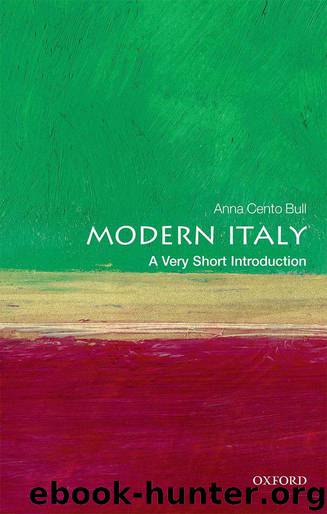Modern Italy: A Very Short Introduction (Very Short Introductions) by Anna Cento Bull

Author:Anna Cento Bull [Bull, Anna Cento]
Language: eng
Format: epub, azw3
ISBN: 9780191039997
Publisher: OUP Oxford
Published: 2016-10-20T06:00:00+00:00
The golden age of the Italian economy
The post-war years marked a period of unprecedented expansion, with GDP growing at a rate of 5 per cent between 1951 and 1963, reaching a peak of 8 per cent in the years after 1957, known as the ‘economic miracle’. This rapid growth was due to a combination of domestic and international factors. Among the former, we find renewed State intervention in the economy coupled with a dynamic and forward-looking managerial style in the public sector; diffused entrepreneurship and inventiveness on the part of a myriad of small family firms in the private sector; and new social values revolving around consumerism and upward social mobility. The country’s founding role in the European Economic Community in 1957 was perhaps the most important external factor in the country’s rapid growth at that time, as it contributed to a very considerable growth in exports, especially in terms of manufactured goods. This was the time when the country became renowned all over the world for its ‘Made in Italy’ brand, especially in textile, clothing, shoe and leather manufacturing, furniture, and interior design. This period was also characterized by renewed and sustained public schemes aimed at promoting the industrialization of the South, overseen and funded by a special State organization, the Cassa per il Mezzogiorno.
One of the positive factors accounting for the country’s economic success was State intervention in the economy. After the war, it took a distinctive form with the setting up of various State-holding companies. These were directed by the Ministry for State Holdings, created in 1956 and managed by a group of technocrats who had in some cases formed their experience in the public sector during the fascist regime. A typical example is Pasquale Saraceno, who during the 1930s had worked at the IRI and in 1946 started working at the newly formed Svimez, a State-funded public–private consortium for the development of the South. Another prominent public manager was Enrico Mattei, who in 1952 became president of the newly formed oil and gas public company, Ente nazionale idrocarburi (ENI). A charismatic figure, Mattei set out to establish an oil supply network as an alternative to the one controlled by the Anglo-American giants, which he dubbed the ‘seven sisters’. His life and premature death in 1962, when his private jet exploded in unexplained circumstances, have since inspired numerous books and various works of fiction. Among these, a 1972 film by acclaimed director Francesco Rosi (The Mattei Case) and, more recently, a 2009 popular TV mini-series entitled Enrico Mattei: The Man Who Looked to the Future.
Enjoying close links with the dominant party in power, Christian Democracy (DC), these managers both shared and upheld a coherent approach to economic development. Their ethos combined a strong belief in the need for State and social planning as a correction to the free market and Catholic values based on class collaboration and solidarity. When the Socialist Party joined the coalition governments in the early 1960s, the prevailing strategy did not change; indeed
Download
Modern Italy: A Very Short Introduction (Very Short Introductions) by Anna Cento Bull.azw3
This site does not store any files on its server. We only index and link to content provided by other sites. Please contact the content providers to delete copyright contents if any and email us, we'll remove relevant links or contents immediately.
| Arms Control | Diplomacy |
| Security | Trades & Tariffs |
| Treaties | African |
| Asian | Australian & Oceanian |
| Canadian | Caribbean & Latin American |
| European | Middle Eastern |
| Russian & Former Soviet Union |
The Secret History by Donna Tartt(18951)
The Social Justice Warrior Handbook by Lisa De Pasquale(12170)
Thirteen Reasons Why by Jay Asher(8848)
This Is How You Lose Her by Junot Diaz(6836)
Weapons of Math Destruction by Cathy O'Neil(6220)
Zero to One by Peter Thiel(5736)
Beartown by Fredrik Backman(5682)
The Myth of the Strong Leader by Archie Brown(5461)
The Fire Next Time by James Baldwin(5386)
How Democracies Die by Steven Levitsky & Daniel Ziblatt(5175)
Promise Me, Dad by Joe Biden(5116)
Stone's Rules by Roger Stone(5053)
A Higher Loyalty: Truth, Lies, and Leadership by James Comey(4909)
100 Deadly Skills by Clint Emerson(4882)
Rise and Kill First by Ronen Bergman(4741)
Secrecy World by Jake Bernstein(4703)
The David Icke Guide to the Global Conspiracy (and how to end it) by David Icke(4658)
The Farm by Tom Rob Smith(4468)
The Doomsday Machine by Daniel Ellsberg(4452)
